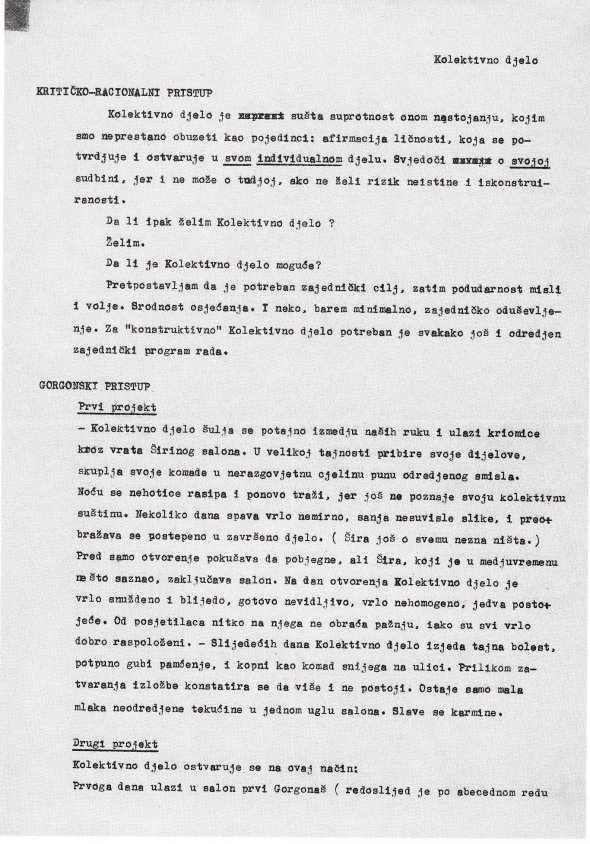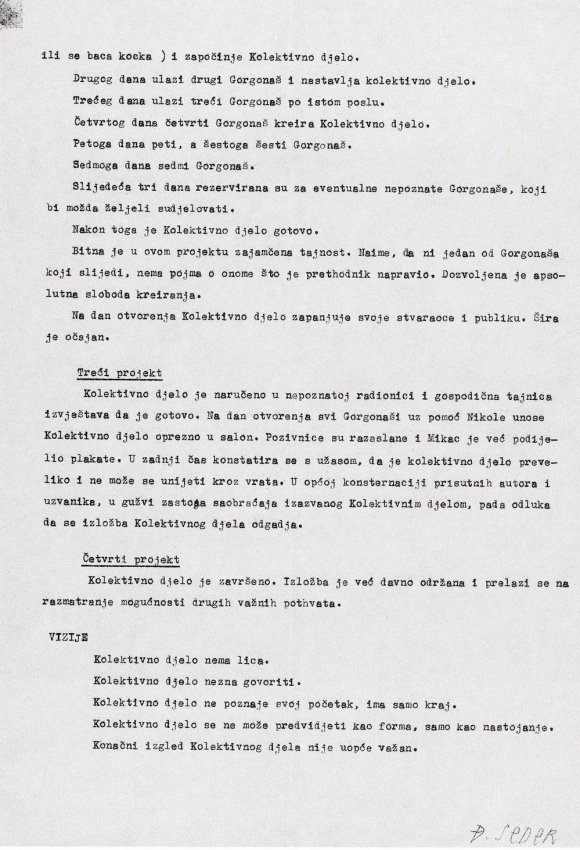Collective Work – Đuro Seder’s response to Gorgona group’s homework assignment
From 1961–63, members of the Gorgona group (comprising artists, architects, and critics) collectively organized and self-funded a series of exhibitions in the “Šira Salon,”[1] a frame shop in Zagreb that Gorgona occasionally rented for its exhibitions. Gorgona’s activities could be seen as a precedent for numerous self-organized artistic exhibitions and spaces that would become a significant marker of the Zagreb art scene of the 1970s.
In place of an exhibition, however, this chronology presents a material trace of another, less visible aspect of Gorgona’s work: activities such as meetings, discussions, collective walks into nature, the exchange and circulation of letters, quotes, thoughts, surveys or assignments among group members. Documentation of these activities were only presented to the public in 1977, when the first exhibition of Gorgona group was organized at the Zagreb Gallery of Contemporary Art, curated by Nena Dimitrijević. Until then, their visibility remained limited to the small circle within and around the group itself, but since its presentation, Gorgona has been seen as a precursor to the New Artistic Practice even if the new generation of artists was able to identify this “point of origin only retroactively.”
In 1963, Radoslav Putar gave all group members a homework assignment – an example of their customary appropriation of bureaucratic and authoritative discourse — demanding that they answer the question as to whether it was possible to produce a “collective work.” Most responses posited collective work as a utopian, or simply an impossible project, unfit for realization. Ivan Kožarić, for example, proposed to make collectively, plaster casts of the inside of of the heads of all Gorgona members. Đuro Seder’s response distinguished between the “critical-rational” and the “Gorgonian” approach to the idea of collective work. In both cases, collective work was a desired ideal, a way to overcome narrow individualist interests and concerns. However, whereas the “critical-rational” approach exhibited a level of certainty in the successful achievement of this ideal, the “Gorgonian approach” highlighted its ultimate impossibility. In each of the four scenarios outlined by Seder, the attempt to create and exhibit a Gorgonian collective work fails as it transforms from idea/desire to materialization/representation. This failure is in all cases bound with the constraints of the exhibition space and its management—here epitomized by “Šira,” the owner of the frame shop. Seder’s four imaginary, failed exhibition scenarios construe the exhibition itself as the epitome of the paradoxes inherent in the (re)presentation of art: the exhibition at the same time communicates and undermines the art’s utopian potential.
The “Collective Work” homework exercise is presented here as an artifact housing questions that continued to haunt and preoccupy artist groups during the 1960s and 1970s: the dialectics between individualism and collectivism, self-organization and institutionalization, visibility and opacity, professionalization and amateurism, state support and autonomy.
Document: Đuro Seder: The Collective Work (1963)
Guide for the chronology (Ivana Bago: Something to think about: values and valeurs of visibility in Zagreb from 1961 to 1986)
Officially named after its owner, but it became Studio G when Gorgona made exhibitions there.
Date: 1963
Participants: Đuro Seder, Gorgona group
Organized by: Radoslav Putar and Gorgona group
Location: Zagreb


